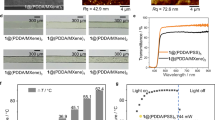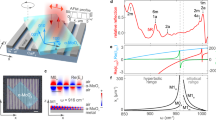Abstract
We control the chain conformation of a semiconducting polymer by encapsulating it within the aligned nanopores of a silica host. The confinement leads to polarized, low-threshold amplified spontaneous emission from the polymer chains. The polymer enters the porous silica film from only one face and the filling of the pores is therefore graded. As a result, the profile of the index of refraction in the film is also graded, in the direction normal to the pores, so that the composite film forms a low-loss, graded-index waveguide. The aligned polymer chains plus naturally formed waveguide are ideally configured for optical gain, with a threshold for amplified spontaneous emission that is twenty times lower than in comparable unoriented polymer films. Moreover, the optimal conditions for ASE are met in only one spatial orientation and with one polarization. The results show that nanometre-scale control of semiconducting polymer chain orientation and position leads to novel and desirable optical properties.
This is a preview of subscription content, access via your institution
Access options
Subscribe to this journal
Receive 12 print issues and online access
$259.00 per year
only $21.58 per issue
Buy this article
- Purchase on Springer Link
- Instant access to full article PDF
Prices may be subject to local taxes which are calculated during checkout




Similar content being viewed by others
References
Schwartz, B. J. Conjugated polymers as molecular materials: How chain conformation and morphology influence energy transfer and interchain interactions. Annu. Rev. Phys. Chem. 54, 141–172 (2003).
Miller, E. K., Yoshida, D., Yang, C. Y. & Heeger, A. J. Polarized ultraviolet absorption of highly oriented poly(2-methoxy,5-(2′-ethyl)-hexyloxy paraphenylene vinylene). Phys. Rev. B 59, 4661–4664 (1999).
Wu, J., Gross, A. F. & Tolbert, S. H. Host–guest chemistry using an oriented mesoporous host: alignment and isolation of a semiconducting polymer in the nanopores of an ordered silica matrix. J. Phys. Chem. B 103, 2374–2378 (1999).
Hide, F. et al. Semiconducting polymers: a new class of solid-state lasing materials. Science 273, 1833–1836 (1996).
Yanagisawa, T., Shimizu, T., Kuroda, K. & Kato, C. The preparation of alkyltrimethylammonium–kanemite complexes and their conversion to microporous materials. Bull. Chem. Soc. Jpn 63, 988–992 (1990).
Kresge, C. T., Leonowicz, M. E., Roth, W. J., Vartuli, J. C. & Beck, J. S. Ordered mesoporous molecular sieves synthesized by a liquid-crystal template mechanism. Nature 359, 710–712 (1992).
Yang, H., Kuperman, A., Coombs, N., Mamiche-Afara, S. & Ozin, G. A. Synthesis of oriented films of mesoporous silica on mica. Nature 379, 703–705 (1996).
Lu, Y. F. et al. Continuous formation of supported cubic and hexagonal mesoporous thin films by sol–gel dip-coating. Nature 389, 364–368 (1997).
Miyata, H. & Kuroda, K. Formation of a continuous mesoporous silica film with fully aligned mesochannels on a glass substrate. Chem. Mater. 12, 49–54 (2000).
Miyata, H., Kawashima, Y., Itoh, M. & Watanabe, M. Preparation of a mesoporous silica film with a strictly aligned porous structure through a sol–gel process. Chem. Mater. 17, 5323–5327 (2005).
Molenkamp, W., Miyata, H. & Tolbert, S. H. Highly-polarized luminescence from optical-quality films of semiconducting polymers aligned within oriented mesoporous silica. J. Am. Chem. Soc. 126, 4476–4477 (2004).
Nguyen, T.-Q., Wu, J., Doan, V., Schwartz, B. J. & Tolbert, S. H. Control of energy transfer in oriented conjugated polymer/mesoporous silica composites. Science 288, 652–656 (2000).
Cadby, A. J. & Tolbert, S. H. Controlling optical properties and interchain interactions in semiconducting polymer by encapsulation in periodic nanoporous silicas with different pore sizes. J. Phys. Chem. B 109, 17879–17886 (2005).
Wan, Y., Yang, H. F. & Zhao, D. Y. Host-guest chemistry in the synthesis of ordered nonsiliceous mesoporous materials. Acct. Chem. Res. 39, 423–432 (2006).
Huo, Q., Margolese, D. I. & Stucky, G. D. Surfactant control of phases in the synthesis of mesoporous silica-based materials. Chem. Mater. 8, 1147–1160 (1996).
Nguyen, T.-Q., Wu, J., Tolbert, S. H. & Schwartz, B. J. Control of energy transport in conjugated polymers using an oriented mesoporous silica matrix. Adv. Mater. 13, 609–611 (2001).
Tessler, N., Denton, G. J. & Friend, R. H. Lasing from conjugated-polymer microcavities. Nature 382, 695–697 (1996).
McGehee, M. D. et al. Semiconducting polymer distributed feedback lasers. Appl. Phys. Lett. 72, 1536–1538 (1998).
Wudl, F. et al. Polymers and an unusual molecular crystal with nonlinear optical properties. ACS Symp. Ser. 455, 683–686 (1991).
Nguyen, T.-Q., Martini, I. B., Liu, J. & Schwartz, B. J. Controlling interchain interactions in conjugated polymers: The effects of chain morphology on exciton–exciton Annihilation and aggregation in MEH-PPV films. J. Phys. Chem. B 104, 237–255 (2000).
McGehee, M. D. et al. Amplified spontaneous emission from photopumped films of a conjugated polymer. Phys. Rev. B 58, 7035–7039 (1998).
Wang, L. & Huang, N. Index profiles: TE mode solutions. IEEE J. Quant. Electron. 35, 1351–1353 (1999).
Schaller, R. D. et al. Nanoscopic interchain aggregate domain formation in conjugated polymer films studied by third harmonic generation (THG) near-field scanning optical microscopy (NSOM). J. Chem. Phys. 117, 6688–6698 (2002).
Schaller, R. D. et al. The nature of interchain excitations in conjugated polymers: Spatially-varying interfacial solvatochromism of annealed MEH-PPV films studied by near-field scanning optical microscopy (NSOM). J. Phys. Chem. B 106, 9496–9506 (2002).
Díaz-García, M. A. et al. Plastic lasers: Semiconducting polymers as a new class of solid-state laser materials. Synth. Met. 84, 455–462 (1997).
Heliotis, G. et al. Investigation of amplified spontaneous emission in oriented films of a liquid crystalline conjugated polymer. Synth. Met. 139, 727–730 (2003).
Martini, I. B., Smith, A. D. & Schwartz, B. J. Evidence for the direct production of interchain species in conjugated polymer films: The ultrafast stimulated emission and fluorescence dynamics of MEH-PPV. Phys. Rev. B 69, 035204 (2004).
Acknowledgements
This work was supported by Canon (S.H.T. and H.M.), by the Office of Naval Research under grant N00014-04-1-0410 (S.H.T. and B.J.S.), and by the National Science Foundation under grants DMR-0305254 (BJS) and CHE-0527015 (B.J.S. and S.H.T.).
Author information
Authors and Affiliations
Corresponding authors
Ethics declarations
Competing interests
The authors declare no competing financial interests.
Supplementary information
Supplementary Information
Supplementary information and supplementary figures 1-2 (PDF 148 kb)
Rights and permissions
About this article
Cite this article
Martini, I., Craig, I., Molenkamp, W. et al. Controlling optical gain in semiconducting polymers with nanoscale chain positioning and alignment. Nature Nanotech 2, 647–652 (2007). https://doi.org/10.1038/nnano.2007.294
Received:
Accepted:
Published:
Issue Date:
DOI: https://doi.org/10.1038/nnano.2007.294
This article is cited by
-
Radio frequency plasma polymerized thin film based on eucalyptus oil as low dielectric permittivity, visible and near-infrared (NIR) photoluminescent material
Journal of Materials Science: Materials in Electronics (2019)
-
Polarized three-photon-pumped laser in a single MOF microcrystal
Nature Communications (2016)
-
A combined experiment and molecular dynamics simulation study on the influence of the crosslinking on the crystallization of comb fluorinated acrylate copolymers
Journal of Materials Science (2014)



